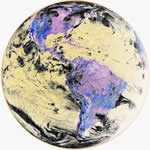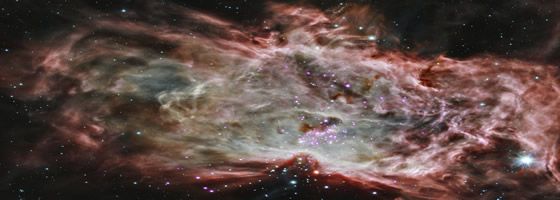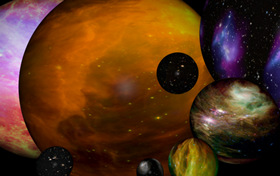Mapping the Multiverse: How Far to the Next Universe?
By Gaurav & Brook Bhagat
“Music in the soul can be heard by the universe” (Lao Tzu). Trust in the universe. This is the best pasta in the universe! People mean different things when they say “universe.” What does “universe” really mean?
One common understanding is that the universe means the totality of existence—everything that stretches out from our own small eyes in a straight line into the blackness of space, going on forever and ever. While this may still work for poetry and pasta ads, modern science sees it differently. String theory, the hippest, stringiest theory in town, defines our universe as everything that exists as a result of our big bang, the one that banged 13-15 billion years ago, creating our galaxy, then our little solar system, our little planet and, eventually, our little selves.
If we define “universe” this way, what would “multiverse” mean? It would mean that there are more universes out there other than our own, which had their own big bangs, and now have their own collection of stuff, ruled by the same or different elemental forces and properties. How many could there be? Maybe they are all separate bubbles, floating through empty space like soap bubbles drifting through the air. If we do live in a multiverse, how far is the closest universe to our universe, the next closest bubble? Could it ever be possible for humans to be able to observe any universe other than our own? In our journey of collective understanding of what “everything” means, our quest to grasp the cosmos and understand our place in it, humanity went from thinking our planet was all there was, to our solar system, our galaxy, and then our universe, containing billions and billions of galaxies; now we are in a multiverse. If this journey of understanding continues to progress exponentially, as it has so far, what conception will come next, after the multiverse?
I was thinking and thinking about it. How far away could the nearest universe be? The vastness is a delicious challenge; I took a shot and played with numbers a bit and came to the estimate of 20 trillion light years as the average distance between two universes.
Does this sound like an outrageous claim? Well, let me explain my simple math, and you can decide if-- as an estimate, obviously-- it’s good enough or not. So, let’s start with some nice, friendly ratios:
Take the ratio of the diameter of a large entity to the average distance between the objects it contains. Our first ratio is the diameter of an average galaxy to the average distance between stars. Our galaxy is considered a large one, having a diameter of about 100,000 light years. Many dwarf galaxies have 10-20k light years’ diameter. After searching a little bit on Google, I found that a generally accepted number is around 45,000 light years for the average diameter of a galaxy in our universe, and also that the average distance between stars is about 5 light years. 45,000/5 gives us 9000 to 1.
Now, the larger entity our galaxy belongs to is our universe. Current estimates for the size (diameter) of our observable universe run as high as 92 billion light years. Certainly, Earth is not the center of the universe, so the diameter must be higher than this. So, we will round up our 92 billion light years to 100 billion light years for our calculation. To find the average distance between galaxies, I used 46 billion light years as the radius and found the volume of our universe using the sphere volume formula. I then divided that by the latest estimate from the Hubble telescope-- that we might have as many as 500 billion galaxies in our universe. That gives us the volume around each galaxy bubble.
Again using the sphere formula, I found the radius of each bubble, which comes out to be 5.8 million light years. So the average distance between the centers of two consecutive bubbles is the sum of their radiuses. Doubling 5.8 million gives us 11.6 million light years. We will round this number down to 11 million because we have to subtract the average diameter of the galaxy so we can find the distance from edge to edge. Now if we find our ratio of the diameter of the universe to the average distance between galaxies, which are 100 billion light years to 11 million light years, it comes out surprisingly close to 9000 to 1, exactly the same as our previous ratio.
 A map of the oldest light in the universe, as recorded by the Plank mission
A map of the oldest light in the universe, as recorded by the Plank mission Courtesy: NASA, ESA and the Planck Collaboration
Building upon this, if the ratio of the diameter of the multiverse-- the next larger entity after the universe-- to the average distance between universes is the same, then all we need is to guesstimate the size of the multiverse and apply our ratio to find the average distance between two universes.
To get a tentative estimate of the diameter of the multiverse, I took the ratio of the diameter of our universe to the average diameter of galaxies. 100 billion light years to 45 million light years comes out to be around 2 million light years. Using this ratio we can guesstimate that the diameter of the multiverse is the diameter of our universe times 2 million, which is 180 quadrillion light years.
Now, we have a guestimate of the diameter of the multiverse, and we know that the ratio of this diameter to the distance between universes is 9000 to 1. To find the average distance between universes, we divide 180 quadrillion light years by 9000 and whoa-- we get the average distance between two universes: 20 trillion light years.
So, does my claim still look outrageous? There are lots of factors which will affect this calculation, of course; at best this is an extremely tentative guesstimate to satisfy my curiosity. Now the question arises: will humans ever be able to see past our universe and observe another universe? I am hopeful, thinking of how much we have accomplished in the last couple centuries. If our civilization continues for a few hundred thousand or few million years, we will have technologies beyond our wildest imaginations. Who knows, one day we will be able to even travel to other universes. What do you think?
Did you like the article? Subscribe here to our New Article Email Alert or RSS feeds.
Sharing is caring! Don't forget to share the love, and keep the conversation going by leaving a comment below:
Advertisement


 By Silver Spoon (Own work) [
By Silver Spoon (Own work) [